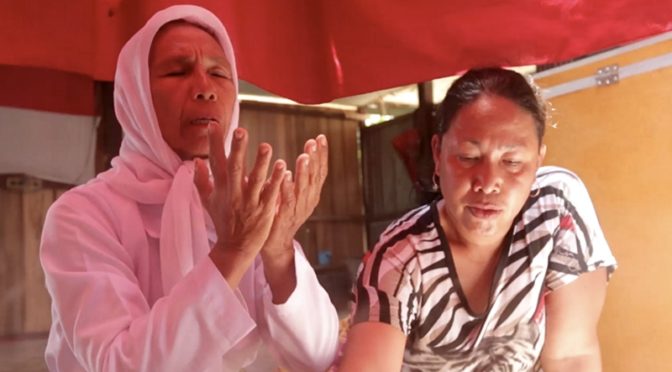While the gender revolution continues to make headlines across western parts of the world, and not a moment too soon, it’s humbling and encouraging to remember that other cultures are way ahead in that regard and always have been. CALALAI: IN-BETWEENNESS serves as a reminder that the question of gender shouldn’t be a polarising political subject, demonstrating instead the ease with which gender fluidity works in the everyday life of a small community.
Director Kiki Febriyanti focuses on the Bugis people of South Sulawesi, Indonesia. The documentary opens with shots of the beautiful landscape of South Sulawesi coupled with close-ups of interiors and locals going about their work – meanwhile, a traditional Bugis song is sung. Viewers are then given a brief rundown of La Galigo, described as “the Bible of the Bugis before they became Moslems.”
La Galigo tells the story of three worlds: Bottilangi, the masculine Upper World; Buriliu – the feminine Under World; and the Middle World, which is a marriage of feminine and masculine. It’s from this world that the culture derives its idea of non-binary genders. There are men and women, but in between there are calabai (closer to women), calalai (closer to men), and bissu (entirely in the middle and androgynous). Bissu individuals are often revered as shamans or spiritual healers and several such figures are introduced during the course of the film.
Information is drawn from both scholars and spiritual healers in the community. Perhaps the most elucidating of these for a person entirely unfamiliar with Bugis culture is Professor Nurhayati Rohman from the Universitas Hasanuddin, who has taken on La Galigo as her scholarly passion. We see her teaching a class on La Galigo and explaining that gender fluidity is both biological and social. For example, a man who acts in a feminine way may be considered a calabai and a woman who acts in a more masculine way may be considered calalai.
There is much to fit into just forty minutes and some snippets are dropped which one might wish to pick up again. It’s mentioned that before WWII most bissu were women but now they are more often men, yet it’s also stated clearly that bissu is exactly in the middle. This is somewhat explained when Mak Temmi, a spiritual leader, discusses becoming bissu for a little while depending on how the spirit takes one at the time. However, discussion quickly moves on from this fascinating idea and no one seems to know why the balance has shifted in favour of men becoming bissu. Additionally, while we see students studying La Galigo, there are no interviews with any of them. This means the film misses the opportunity to include a youth perspective on La Galigo and Bugis culture. In contrast, much time is given to the rituals performed by the bissu spiritual healers. While they are engaging, they’re also utterly puzzling to an outsider and there is little by way of explanation as to what the rituals are hoping to achieve.
The main allure of this film is a simple acceptance it shows of how things are. The Bugis have had five genders for as long as anyone can remember. The culture is happy for people to move from one end of the spectrum to the other with neither plaudits nor opprobrium. When political media increasingly feed on – and seek to create – mass hysteria in either one of those directions, CALALAI: IN-BETWEENNESS is a welcome disruption to that narrative.
CALALAI: IN-BETWEENNESS screens October 22nd at CCA Glasgow at 5:30pm in partnership with SQIFF.

